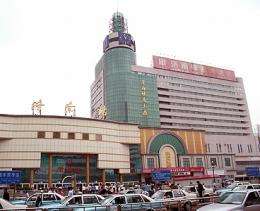3 Questions: Dennis Frenchman on making cities sustainable

Over the past two years, Dennis Frenchman, a professor in MIT’s Department of Urban Studies and Planning (DUSP), and Christopher Zegras, an associate professor in DUSP, have run an academic group investigating the relationship between urban form and energy use in China. Working with colleagues at Beijing’s Tsinghua University, Frenchman and Zegras have focused their research on the city of Jinan. Frenchman spoke with MIT News about principles of urban sustainability.
Q. The project you and Christopher Zegras have run in Jinan, China, aims to make urban planners more conscious of energy efficiency. What are the biggest hurdles China now faces in making its cities more sustainable?
A. The biggest city-planning challenge that China now faces is to encourage a different form of urbanization than the design model currently being built. The model consists of widely separated high-rise towers in single-use residential districts — the “tower-in-a-park” model invented in the 1920s in Europe, when cars were few and energy cheap. Our work has shown that this way of living consumes almost twice as much energy as any other form of development, such as, for example, a conventional, mixed-use urban neighborhood on a grid of streets and blocks. The findings are based on analysis of the different physical forms in 24 neighborhoods in Jinan and how people actually live in them and consume energy.
This makes intuitive sense. If you have to go down an elevator, go to a parking garage, and use a car every time you need a loaf of bread, you are going to consume a lot of energy. But it’s also more subtle than that. The issue is not the towers, but the fact that they’re in parks. People living in the same towers placed on the streets of Manhattan would consume less energy. Think of all the chance encounters and social interactions you have with people across a day at MIT. By contrast, if you live in a tower-in-a park, to meet someone you have to make a deliberate move. All those moves add up, and you’re burning energy. Yet, this is the kind of development being taken for granted in China. Meanwhile the government has very ambitious goals for reducing carbon in the atmosphere, which I feel will be impossible to meet if they continue to roll out this kind of neighborhood development to house 300 million new urban dwellers in the next 20 years.
So you can make buildings consume less energy, and cars burn less fuel, but as long as you’re sticking people into an inefficient 20th-century urban form, you’ll never reach the mark. At the same time, there is a misconception that any high-density development will be energy efficient. Not all density is equal. How the neighborhood is designed is a critical factor.
Q. You’ve also studied more efficient urban forms globally. What do the parts of cities that are more sustainable have in common?
A. There have been a lot of impressive demonstration neighborhoods developed, like Greenwich Millennium Village or BedZED (Beddington Zero Energy Development) in London. They are all higher-density than their surroundings, they all involve good alternatives to the automobile, they are all mixed-use neighborhoods with businesses and schools and more. They are all attached to cities, not in the suburbs. But another interesting characteristic is that they are all designed as communities that encourage people to embrace the energy ideal. They tend to have mixed-use urban streets and public squares and all the old-time things you expect in a livable neighborhood.
One surprise is that efficient forms recur. There are a thousand variables that go with any urban design, but there are certain forms that tend to predominate. We have now identified about six prototypical urban forms for energy-efficient neighborhoods. Our students have demonstrated this, working in China with the MIT-Tsinghua joint urban design studio. Of course, each project is its own system; projects vary based on site, pattern of streets, climate, even orientation to sunlight. What works in one place may not work so well a mile away. Which is great for design, by the way. If you want to optimize for energy efficiency, you can’t just cookie-cut. Each site is its own world.
Q. How, specifically, can this kind of research be applied to planning, in China or elsewhere?
A. We’re not just trying to understand the relationship between urban form and energy consumption, but to invent a common basis for measuring neighborhood energy performance, using what we call the Energy Pro Forma. It is based on the concept of a financial pro forma [used to assess the financial performance of real estate projects; MIT researchers have copyrighted the “Energy Pro Forma” term]. This would allow developers, designers or policymakers to measure the energy performance of a neighborhood in a comparable way. And when we design, we would have quick feedback about whether we’re going in the right direction. The entire world knows how we calculate the financial return on a project. We are trying to calculate the energy return. Ultimately, what we’re aiming for is a one-number index, as exists for automobile fuel efficiency.
Right now, policymakers in China tend to think about improving the energy efficiency of development by seeking “the perfect form.” And they’re very oriented around a top-down structure: Tell developers what they need to do. But we know there’s no one perfect form. What we want to give people is a commonly accepted way to measure the energy performance of a project and a target index number, and let them figure out how to reach it. That allows design innovation to occur.
This story is republished courtesy of MIT News (web.mit.edu/newsoffice/), a popular site that covers news about MIT research, innovation and teaching.
Provided by Massachusetts Institute of Technology



















